You are here
Back to topImpacts of Cleaning Process on Power Converter
Soldering is an important step in electronics manufacturing, and there is always flux or other contaminants left after soldering. Flux usually contains chemicals such as "acid" and "salt" in order to resist oxidation. If there is too much residue on the surface of the printed circuit board, it will mix with moisture and pollutants in the air, causing corrosion to the copper surface, which may cause conduction, and resulting in increased leakage current, standby current. This article will discuss the impact of different cleaning processes on printed circuit boards containing converter modules.
1. Types of Circuit Board Cleaning Processes
1.1 Solvent Cleaning
Using organic solvents to dissolve residue. Due to environmental protection issues, solvents containing CFCs, such as CFC-13, TCA, etc. No need to go through drying process、 non-flammable, and it can be reused through distillation to reduce waste liquid generation, etc. It has low surface tension and can penetrate into any small crevices to achieve better cleaning effect.
Now, fluorine-based solvents such as HCFC and HFC are used, but they are also gradually phased out due to environmental protection issues, and gradually replaced by hydrocarbon solvents such as FRB.
1.2 Aqueous Cleaning
- Aqueous Cleaning Process
Aqueous cleaning uses water as the cleaning medium. In order to improve the cleaning efficiency, add a small amount of chemical substances, such as surfactants, detergents, corrosion inhibitors, etc.
- Semi-Aqueous Cleaning Process
For semi-aqueous cleaning, the proportion of water only accounts for 5~20% of the cleaning agent. Both processes will go through three steps of cleaning, rinsing, and drying.
It has a good dissolving effect on water-soluble residue because surfactants are added to reduce the surface tension of water. Allowing the solvent to better clean printed circuit boards with a large number of SMD components. The main cleaning method of aqueous cleaning is similar to a dishwasher, and cleaning methods such as spray and ultrasonic can also be selected.
1.3 No-Clean Process
No-clean process uses low-residue flux and solder paste, and it can ensure that residue on the board does not affect reliability. Fully automated production is required to avoid contact pollution such as hand sweat and fingerprints. The no-clean process requires the quality and composition of soldering materials. No-clean flux has low solid content, so there is no way to form an insulating protective layer on the printed circuit board after soldering, so it cannot contain halogens, rosin and other ingredients. The advantage is that there is no need to purchase extra cleaning equipment, and the discharge waste water and exhaust gas can also be reduced, which can greatly reduce expenses. However, it is only limited these products that do not have requirements on the environment. To use the products in harsh environment, it is recommended to be cleaned.
2. Effect of Cleaning Process on Converter
The cleaning process and solvents are very different from the past due to the miniaturization of electronic components mainly, the increasing density of printed circuit boards, and lead-free solder. These reasons change the flux composition.
Reliability requirements of medical and railway products especially have increased nowadays. Hence, the main point of choosing cleaning agent is not only selecting the right solvent that can match the components of the flux, but also the surface tension of the solvent is the key point. The lower the surface tension, the deeper it can penetrate into the crevices and carry away contaminants.

However, the solvent penetration becomes stronger. It will easy to penetrate into the gaps of packaged components. So, it is not recommended to go through the cleaning process for the converter. It can cause the liquid to enter and expand when drying. It will damage the package. Although the conduction caused by the flux residue is reduced, the failure risk of the power module is increased.
3. Conclusion
Due to the miniaturization of electronic components, new cleanable solvents require low surface tension to increase the ability of penetrating into the crevices of SMD components. So, there is the possibility of residual cleaning fluid at the seams of the converter, resulting in the risk of damage.
CTC is a professional service provider for high-end power supply modules (AC to DC Converter and DC to DC Converter) for critical applications worldwide since 30 years. Our core competence is to design and deliver products with leading technologies, competitive pricing, extremely flexible lead-time, global technical service and high-quality manufacturing (Made In Taiwan).
CTC is the only corporation certificated with ISO-9001, IATF-16949, ISO22613(IRIS), and ESD/ANSI-2020. We can 100% ensure not only the product, but also our workflow and service to match quality management system for every high-end application from the very beginning. From design to manufacturing and technical support, every single detail is operated under highest standard.

